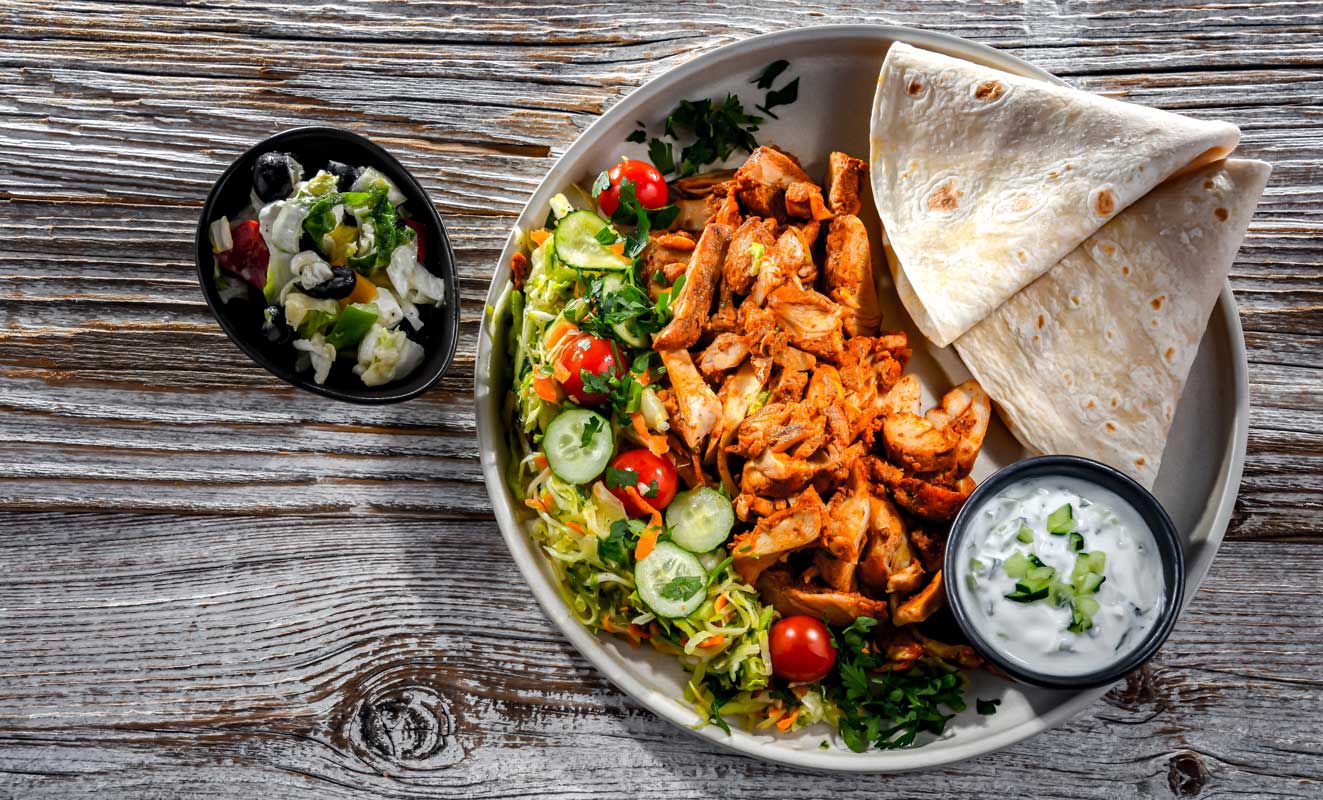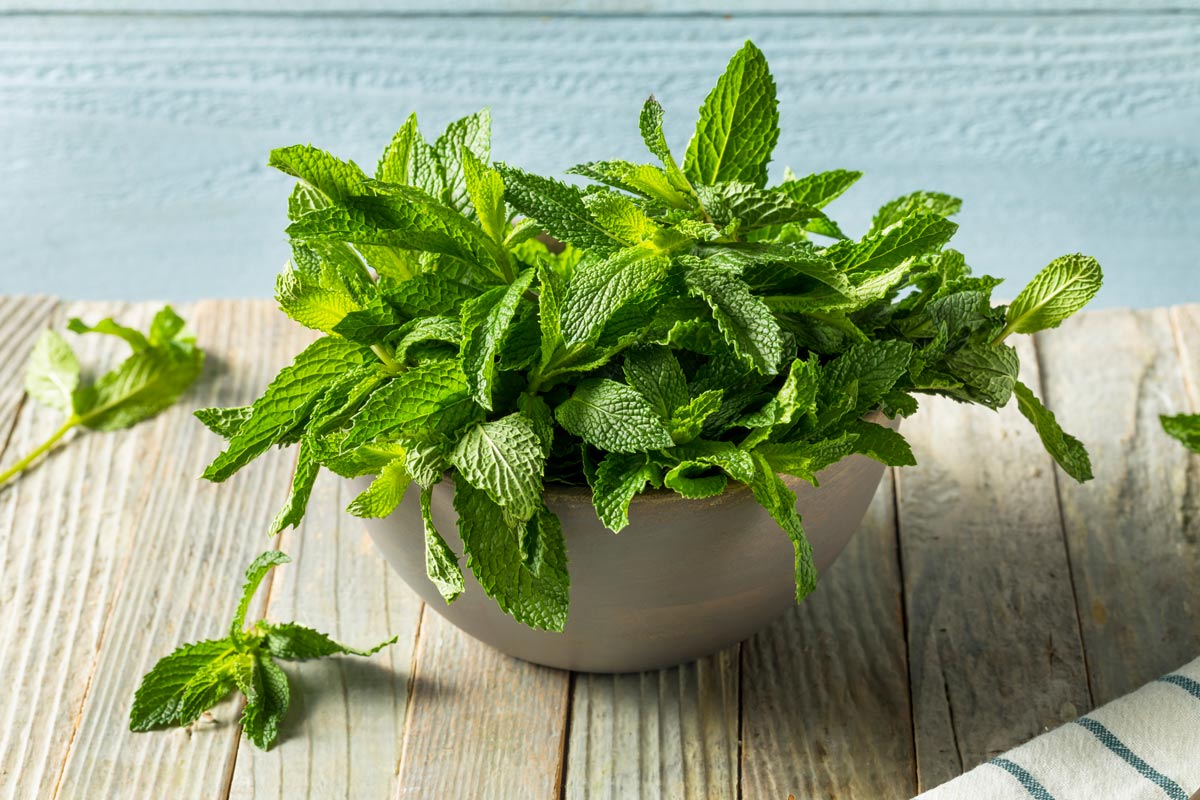Sheet Pan Souvlaki Recipe, Spotlight on Mint, How to Choose Skewers, The “Secret Sauce” for Losing Weight and The Long Reach of Exercise
Warm weather reawakens my desire for effortless cooking, but I still want food that’s intensely flavorful. This take on chicken souvlaki is the perfect answer—simple and succulent. It relies on a wonderful mix of spices enhanced by extra virgin olive oil. It’s also an excellent example of how delicious food can be good for you. For many people, higher temperatures also reawaken the desire to get into summer shape. Timely research on how the human touch can be more helpful than apps for weight loss may have you rethinking hiring a nutrition coach. As you prep for summer activities, you’ll be fascinated by new research on just how wide-reaching the benefits of exercise is for every part of your body.
Sheet Pan Souvlaki
 Sheet Pan Souvlaki
Sheet Pan SouvlakiTraditional souvlaki is, of course, meat grilled on skewers. This version of one of my favorite recipes is perfect for those times when you can’t get to the grill but want to taste souvlaki’s deep, rich spices. Besides the traditional way of serving souvlaki on a pita with tzatziki sauce, this chicken is delicious over rice with a side of tomatoes and cucumber and my light, minty yogurt dressing.
Ingredients
For the chicken:
- 4 tablespoons extra virgin olive oil, divided use
- Juice of 1 large lemon
- 4 garlic cloves, very finely minced
- 1 teaspoon coarse sea salt
- 1 teaspoon freshly ground black pepper
- 1 teaspoon ground cumin
- 1 teaspoon ground coriander
- 1 teaspoon allspice
- 2 teaspoons sweet paprika
- 1/2 teaspoon cayenne
- 1/2 teaspoon turmeric
- 2 pounds boneless, skinless chicken thighs
- 2 large red onions, peeled and cut into eighths
For the yogurt dressing:
- 1 cup plain Greek yogurt
- 1 tablespoon lemon juice, more to taste
- 2 tablespoons extra virgin olive oil, plus more for drizzling
- 2 garlic cloves, finely minced
- 1/4 teaspoon sea salt
- 2 tablespoons chopped fresh dill
- 2 tablespoons chopped fresh spearmint
Directions
Step 1
In a bowl large enough to hold the chicken, make a marinade by whisking together 2 tablespoons olive oil, the lemon juice, garlic, salt, and all the spices.
Step 2
Using a cutting board reserved for raw meat, cut the thighs into evenly sized strips. Place the strips in the marinade and toss to coat. Allow the chicken to marinate on a counter for 30 minutes, or up to overnight in the fridge.
Step 3
When ready to cook, preheat your oven to 350°F. Use a tablespoon of olive oil to lightly coat a rimmed sheet pan. Spread out the strips. Drizzle the onions with olive oil and arrange them among the chicken pieces. Bake for 30 minutes or until an instant-read thermometer reaches 165°F when testing a few chicken strips.
Step 4
While the chicken is roasting, make the yogurt dressing by whisking together all its ingredients. Taste and add more salt, pepper, and/or lemon juice if desired. (If you want to make the sauce in advance, keep it in the fridge until needed). Just before serving, drizzle the top with more olive oil.
Step 5
To serve, plate strips of chicken with the red onions along with the yogurt dressing and your choice of sides or pitas.
Yields 4 to 6 servings

Healthy Ingredient Spotlight
Choosing Mint

Many recipes that call for mint don’t specify the type to use. Unless you grow your own, you might be surprised to learn that there are well over a dozen varieties, with spearmint and peppermint being the most well-known yet quite different in taste and appearance.
There’s a good reason that candies and drinks, especially around the holidays, feature peppermint. Peppermint is 40% menthol, and it’s the menthol that tingles your palate. Spearmint, on the other hand, has almost no menthol. It gets its sweetish taste from a phytochemical called carvone, and that makes it perfect when you want just a nuance of mint in dishes like yogurt dressing, tabbouleh, or mint sauce for lamb.
Both types of mint make great additions to your herb garden or window box—once you have them at your fingertips, you’ll look for even more ways to enjoy them.

Quick Kitchen Nugget
When You Want to Grill: Choosing Skewers
With summer grilling season upon us, it’s time to take stock of your BBQ tools. Whether you want to grill meat, veggies, or fruit, having a selection of skewers is a must. While bamboo skewers are great for finger foods, but for grilling, the soaking process and their shorter size make them more work than strong metal ones. And, of course, they’re not reusable.
There are many styles of metal skewers to choose from. I recommend looking for some specific features that make them easier to handle and thread. The skewer itself should be at least 12 inches long. You can find skewers that are nearly a foot and a half in length, but before you make any purchase, make sure they will fit inside your grill! I also prefer those with a wide, flat surface that ends in a sharp point, better for piercing raw meat and harder veggies and fruits.

Helpful hack: Coat your skewers with a few drops of extra virgin olive oil before loading them up—the cooked food will release that much more easily.
Also aim for skewers with heat-resistant handles that are easy to grab—do still wear grill mitts for safety—rather than skewers with only a metal ring. As convenient as online shopping is, if possible, test out different brands at a physical store to see which ones fit best in your hand.
Wash and dry your skewers as soon as feasible after cooking. That’s when traces of food will come off more readily (dropping them into your sink for a soak in warm soapy water for a few minutes will help).

For Your Best Health
The “Secret Sauce” for Losing Weight
As great as the need is for low-cost, effective weight loss treatments, current technology—even with all the apps available—is not advanced enough to replace human coaches, according to the SMART study conducted by Northwestern Medicine and published in JAMA.
“Giving people technology alone for the initial phase of obesity treatment produces unacceptably worse weight loss than giving them treatment that combines technology with a human coach,” said corresponding study author Bonnie Spring, PhD, director of the Center for Behavior and Health and professor of preventive medicine at Northwestern University Feinberg School of Medicine.
In the study, people who initially only received technology without coach support were less likely to achieve meaningful weight loss, considered to be at least 5% of body weight, compared to those who also had a human coach. Investigators intensified treatment quickly (by adding resources after just two weeks) if a person showed less than optimal weight loss, but the weight loss disadvantage for those who began their weight loss effort without coach support persisted for six months, the study showed. Note: It is possible for some people to achieve clinically meaningful weight loss without anti-obesity medications, bariatric surgery, or even behavioral treatment, Dr. Spring said. In the SMART study, 25% of people who began treatment with technology alone were able to achieve a 5% weight loss after six months without any treatment augmentation. But that means 75% were not.
Eventually, more advanced technology may be able to supplant human coaches, Dr. Spring said. “We may not be so far away from having an AI chatbot that can sub for a human, but we are not quite there yet. It’s within reach. The tech is developing really fast.”
Scientists are now trying to parse what human coaches do that makes them so helpful, and how AI can better imitate a human, not just in terms of content but in emotional tone and context awareness, Dr. Spring added.
An unsolved problem is matching treatment type and intensity to individuals’ needs and preferences. “If we could just tell ahead of time who needs which treatment at what intensity, we might start to manage the obesity epidemic,” Dr. Spring added.

Fitness Flash
The Long Reach of Exercise
The health benefits of exercise are well-known, but new research published in the journal Nature shows that the body’s response to exercise is more complex and far-reaching than previously thought. In a lab study on rats, a team of scientists from across the United States found that physical activity caused many cellular and molecular changes in all 19 of the organs they studied in the animals!
Exercise lowers the risk of many diseases, but scientists didn’t fully understand how it changes the body on a molecular level. This is partly because most studies have focused on exercise’s effects on a single organ or on one gender only, among other limited variables. To take a more comprehensive look at the biology of exercise, scientists with the Molecular Transducers of Physical Activity Consortium (MoTrPAC) used an array of techniques in the lab to analyze molecular changes in rats as they were put through their paces with weeks of intense exercise.
The team studied a range of tissues from the animals, such as the heart, brain, and lungs. They found that each of the organs they looked at changed with exercise, helping the animals regulate their immune system, respond to stress, and control pathways connected to inflammatory liver disease, heart disease, and tissue injury.

The data provide potential clues to many different human health conditions. For example, the researchers found a possible explanation for why the liver becomes less fatty during exercise, which could help in the development of new treatments for metabolic dysfunction-associated steatotic liver disease (formerly called non-alcoholic fatty liver disease). “Even though the liver is not directly involved in exercise, it still undergoes changes that could improve health. No one speculated that we’d see these acetylation and phosphorylation changes in the liver after exercise training,” said Pierre Jean-Beltran, PhD, a co-first author of the study and a postdoctoral researcher at Broad Institute of MIT and Harvard, when the study began. “This highlights why we deploy all of these different molecular modalities—exercise is a very complex process, and this is just the tip of the iceberg.”
“Two or three generations of research associates matured on this consortium project and learned what it means to carefully design a study and process samples,” added Hasmik Keshishian, PhD, a senior group leader under Steve Carr, senior director of Broad’s Proteomics Platform, and co-author of the study. “Now we are seeing the results of our work: biologically insightful findings that are yielding from the high-quality data we and others have generated. That’s really fulfilling.”
Additional MoTrPAC studies are underway to study the effects of exercise on young adult and older rats, and the short-term effects of 30-minute bouts of physical activity. The consortium has also begun human studies and is recruiting about 1,500 individuals of diverse ages, sexes, ancestries, and activity levels for a clinical trial to study the effects of both endurance and resistance exercise in children and adults.
The team hopes that their findings could one day be used to tailor exercise to an individual’s health status or to develop treatments that mimic the effects of physical activity for people who are unable to exercise.
Get More Recipes In Your Inbox!